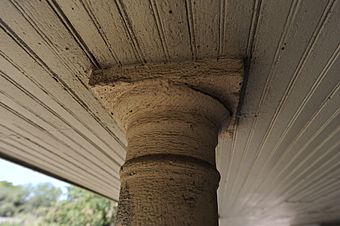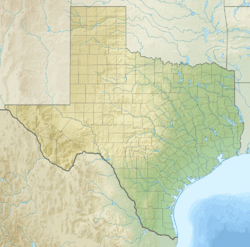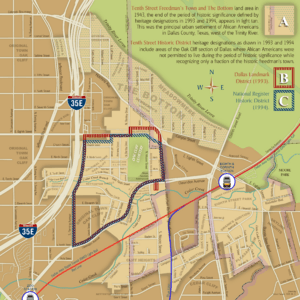Tenth Street Freedman's Town facts for kids
|
Tenth Street Historic District
|
|

Porches define the character of historic Tenth Street.
|
|
| Location | Western edge of William S. Beatty Survey, Northeast corner William H. Hord Survey, Southeast corner Elizabeth Robertson Survey, Dallas, Texas |
|---|---|
| Area | Approximately 84 acres (34 ha) |
| Built | 1888-1947 |
| Architect | African American carpenters including Noah Penn, Richard J. Moore, and John Siler, among many others. |
| Architectural style | Folk Victorian, Late 19th and 20th Century Revivals, American Craftsman, Shotgun House, Bungalow |
| NRHP reference No. | 94000604 |
Quick facts for kids Significant dates |
|
| Added to NRHP | June 17, 1994 |
The Tenth Street Freedman's Town is a special historic community in the Oak Cliff area of Dallas, Texas. It was founded by African Americans who were once enslaved. These people became free during and after the American Civil War.
The community that became known as Tenth Street started near two creeks, Cedar Creek and Cedar Creek Branch. It was also close to an African American burial ground that dates back to 1846. The name "Tenth Street" became popular in 1887. This was when John Scarborough Armstrong and Thomas Lafayette Marsalis planned out the town of Oak Cliff.
Contents
Protecting History: Tenth Street's Designations
The Tenth Street Historic District is a special area recognized for its history. It can mean two things: a local Dallas Landmark District or a National Register Historic District. Both protect parts of the Tenth Street Freedman's Town.
These designations help save the community's important past. They make sure that some of the original homes and buildings are kept safe. However, only a part of the original community is protected today. Some areas that were once part of the community are not included in these protected zones.
Even though the local and national districts were created for the same community, their exact borders are a little different. These districts help honor the history of the people who built this unique place.
A Look Back: The History of Tenth Street
The first African Americans in what is now Oak Cliff arrived around 1843. They were enslaved people who came with settlers like George Lawan Leonard. By 1846, there were about twelve enslaved people in the area.
A man named William S. Beatty set aside ten acres of land for a public cemetery in 1846. He said it should "remain forever open to all." Enslaved people were buried in the southern part of this cemetery, along what later became Tenth Street.
After the Civil War ended in 1865, many formerly enslaved people moved to Texas cities. They were looking for family members and new chances in life. Arch Miller, who had been enslaved, settled near Cedar Creek, south of the burial ground.
Building a Community
In November 1887, land sales began for the planned city of Oak Cliff. But African Americans were not allowed to buy land in the main part of Oak Cliff. However, the land near the burial ground and creeks was different. It was not restricted.
In October 1887, W.J. Betterton bought a four-acre piece of land. He extended Tenth Street across the cemetery. In January 1888, Anthony Boswell became one of the first Black people to buy land here. This marked the start of Black land ownership in Oak Cliff.
Churches also bought land in this area before 1890. These included the trustees of Elizabeth Chapel C.M.E. Church and El Bethel Missionary Baptist Church.
Growth and Challenges
For a while, Black land ownership was mostly limited to these "Four Acres." But then, in 1893, there was a financial crisis called the Panic of 1893. Many investors quickly sold off their empty lots. This was a tough time for Oak Cliff, but it was a chance for Tenth Street.
Black Tenth Street grew westward into the original Oak Cliff area. It became a lively place with many businesses and homes. This community thrived, especially during the Jazz Age.
In 1903, the first public school for "colored" students opened at the site of N.W. Harllee. Many famous people attended this school. These include Rafer Johnson, who won an Olympic gold medal in 1960. Another famous student was Aaron Thibeaux “T-Bone” Walker, a blues guitarist who made the electric guitar popular in blues music.
On September 8, 1935, jazz saxophonist James Earl Clay was born on Cliff Street. This was right behind the Greater El Bethel Missionary Baptist Church. Clay also went to N.W. Harllee before graduating from Lincoln High School in South Dallas.
In 1937, Mose Hursey, who had been enslaved, shared his life story. He told it to the Federal Writers' Project. His story is now part of the Slave Narrative Collection at the Library of Congress.
Over the years, some homes and businesses were lost. This happened when new roads like Clarendon Drive (1942-1950) and the R.L. Thornton Freeway (late 1950s) were built. However, the community still kept much of its original look. Because of this, the National Park Service added the Tenth Street Historic District to the National Register of Historic Places in 1994. They noted that losing buildings, rather than new construction, was the main challenge for the neighborhood.
Getting Around: Transportation
Light Rail
The DART light rail system serves the area.
- 8th & Corinth Station is nearby.
Famous People from Tenth Street
- James Earl Clay: A talented jazz saxophonist known as "Texas Tenor."
- Rafer Johnson: An Olympic gold medalist in the decathlon and an actor.
- Aaron Thibeaux "T-Bone" Walker: A legendary blues guitarist.




